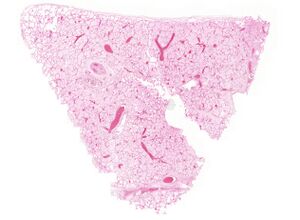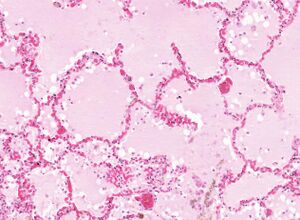18. Pulmonary oedema
Staining: HE
Organ: Lung
Description:
Even with low magnification can we immediately see that the alveolar spaces are filled with fluid. Upon closer inspection can we see that this fluid is slightly eosinophilic.
Diagnosis: Pulmonary oedema
Causes:
- Acute left ventricular failure
- (Acute respiratory distress syndrome)
Theory:
Because the fluid is only pale eosinophilic can we understand that the protein content of it is low, meaning that it is transudate and not exudate fluid.
Pulmonary oedema occurs only in case of acute left ventricular failure and not in chronic. In acute failure will venous congestion develop quickly which increases the intravascular hydrostatic pressure in the lung vessels. According to the Starling equation will this lead to fluid filtration out of the vessels into the interstitium, which fills up the alveolar spaces.

